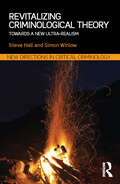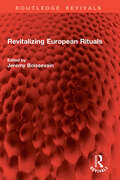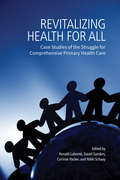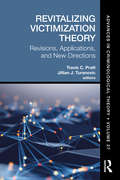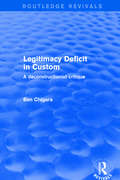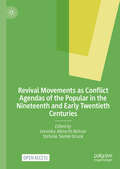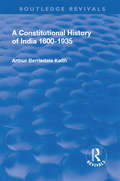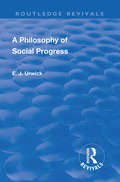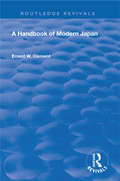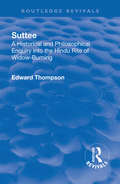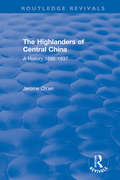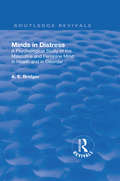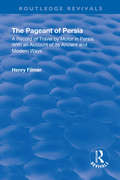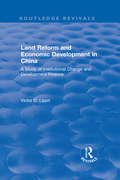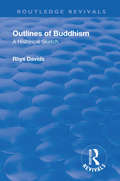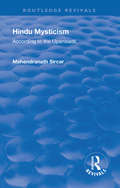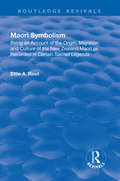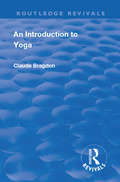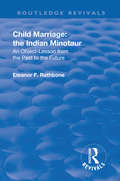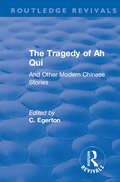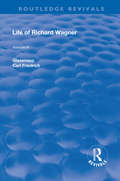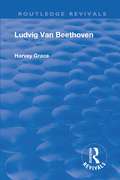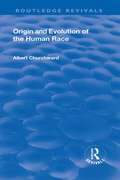- Table View
- List View
Revitalizing Criminological Theory: Towards a new Ultra-Realism (New Directions in Critical Criminology)
by Steve Hall Simon WinlowThis book provides a short, comprehensive and accessible introduction to Ultra-Realism: a unique and radical school of criminological thought that has been developed by the authors over a number of years. After first outlining existing schools of thought, their major intellectual flaws and their underlying politics in a condensed guide that will be invaluable to all undergraduate and postgraduate students, Hall and Winlow introduce a number of important new concepts to criminology and suggest a new philosophical foundation, theoretical framework and research programme. These developments will enhance the discipline’s ability to explain human motivations, construct insightful representations of reality and answer the fundamental question of why some human beings risk inflicting harm on others to further their own interests or achieve various ends. Combining new philosophical and psychosocial approaches with a clear understanding of the shape of contemporary global crime, this book presents an intellectual alternative to the currently dominant paradigms of conservatism, neoclassicism and left-liberalism. In using an advanced conception of "harm", Hall and Winlow provide original explanations of criminal motivations and make the first steps towards a paradigm shift that will help criminology to illuminate the reality of our times. This book is essential reading for academics and students engaged in the study of criminology, sociology, criminological theory, social theory, the philosophy of social sciences and the history of crime.
Revitalizing European Rituals (Routledge Revivals)
by Jeremy BoissevainFirst published in 1992, Revitalizing European Rituals explores why revitalization of celebrations is taking place in communities throughout Europe. The festive behaviour appears to contradict the sober, rational conduct associated with modernization and industrialization. The contributors examine fairs, carnivals, fiestas, Holy Week, and national rituals in Britain, Poland, Spain, Italy, Malta and Greece. They have lived and worked in the communities they describe, celebrated the festivities they analyse, and have discussed them with the celebrants.The underlying reasons for the revival are complex and examined fully. The conclusions provide surprising insights into the changes sweeping across Europe. This book will be valuable reading for researchers and lecturers in social anthropology, sociology, religious studies, cultural studies, and tourism.
Revitalizing Health for All: Case Studies of the Struggle for Comprehensive Primary Health Care
by David Sanders Corinne Packer International Development Research Centr Nikki Schaay Ronald LabontéThe concept of Comprehensive Primary Health Care focuses on health system efforts to improve equity in health care access, community empowerment, participation of marginalized groups, and actions on the social determinants of health. Despite its existence since the late 1970s very few studies have been able to highlight the outcomes of this concept, until now. Revitalizing Health for All examines thirteen cases of efforts to implement CPHC reforms from around the globe including Australia, Brazil, Democratic Republic of Congo, Iran, South Africa, and more. The findings presented in this volume originate from an international action-research set of studies that utilized triads of senior and junior researchers and knowledge users from each country’s public health system. Primary health care reform is an important policy discourse both at the national level in these countries and in the global conversations, and this volume reveals the similarities among CPHC projects in diverse national contexts. These similarities provide a rich evidence base from which future CPHC reform initiatives can draw, regardless of their country.
Revitalizing Minority Languages: New Speakers of Breton, Yiddish and Lemko (Palgrave Studies in Minority Languages and Communities)
by Michael HornsbyNew speakers are an increasingly important aspect of the revitalization of minority languages since, in some cases, they can make up the majority of the language community in question. This volume examines this phenomenon from the viewpoint of three minority languages: Breton, Yiddish and Lemko.
Revitalizing Victimization Theory: Revisions, Applications, and New Directions (Advances in Criminological Theory)
by Travis C. PrattRevitalizing Victimization Theory: Revisions, Applications, and New Directions revises some of the major perspectives in victimization theory, applies theoretical perspectives to the victimization of vulnerable populations, and carves out new theoretical territory that is clearly needed but has yet to be developed. With the exception of a handful of isolated works in the mid-twentieth century, theory and research on victimization did not come into its own until the late 1970s with the articulation of lifestyle and routine activity theories. Research conducted within this tradition continues to be an important part of the overall criminological enterprise, and a large body of empirical knowledge has been generated. Nevertheless, theoretical advances in the study of victimization have largely stalled within the field of criminology. Indeed, little in the way of new theoretical headway has been made in well over a decade. This is an ideal time to revitalize victimization theory, and this volume does just that. It is an ambitious project that will hopefully reignite the kinds of theoretical discussions that once held the attention of the field. The work included here will shape the future of victimization theory and research in years to come. This volume should be of interest to a wide range of criminologists and have the potential to be used in graduate seminars and upper-level undergraduate courses.
Revival (2001): Towards a Deconstructionist Theory
by Ben ChiagraThis title was first published in 2001. A discussion of customary international law (CIL). Throughout the study particular values are examined for their potential effect on the legitimacy of the process of custom. The writer argues that, in order to achieve legitimacy enhancing transparency in the process of custom, it must be acknowledged first that the power applied by international tribunals when they inaugurate new norms of customary international law always creates categories of "dominance" and "subservience", "inclusion" and "exclusion". Such an acknowledgement would foster a situation where both the power applied by tribunals and the manner in which it is applied, can legally be scrutinized for excesses that limit first the transparency of the process of custom, and second the legitimacy of norms of customary international law.
Revival Movements as Conflict Agendas of the Popular in the Nineteenth and Early Twentieth Centuries
by Veronika Albrecht-Birkner Stefanie Siedek-StrunkThis open access book focuses on the potential for conflict between high and low culture during the transformations of the popular in the field of religion in the nineteenth and early twentieth centuries. Specifically, the contributors to this edited collection consider the so-called 'Revival Movements' that came up as a symptom of differentiation and pluralisation of Protestantism in reaction to the Enlightenment, rationalism, and criticism of religion, and explore the attempts at theological self-empowerment of Christian laymen and laywomen.
Revival of the Runes: The Modern Rediscovery and Reinvention of the Germanic Runes
by Stephen E. Flowers• Explores the five periods of runic revival: the Renaissance, the Enlightenment, the Romantic period, the early 20th century, and the late 20th century • Examines the use of runes by the foremost magicians and scholars of each era, including mystic and scholar Johannes Bureus, who developed his own integrated system of runology known as Adalruna • Reveals how the Nazi misguided use of the runes showed a lack of comprehension of what was being discovered by scientific rune scholars of the day In this exploration of the history of the runes from 1500 CE to the present day, Stephen Edred Flowers examines the five periods of runic revival: the Renaissance, the Enlightenment, the Romantic period, the early 20th century, and the late 20th century. For each period, he discusses both the scholarly studies and those focused on the esoteric mysteries of the runes--and how these two branches of study were at first intertwined yet diverged in later revivals. Focusing in particular on the first runic revival, Flowers examines the use of runes during the Renaissance by the foremost magicians and scholars of the era, including mystic and scholar Johannes Bureus, the &“grandfather of integral runology,&” who developed his own system known as Adalruna. In his examination of the runic reawakenings of the early and late 20th century, Flowers looks at how the runes were employed as part of a reassessment of Germanic identity, one school of which led to Nazi Germany. He explains how the Nazi use and abuse of the runes was misguided and revealed a lack of comprehension of what earlier rune scholars had discovered through their extensive studies of the past. He also offers a fresh look at the work of Guido von List and clears him of his guilt by association with the Nazis. Detailing the multilayered history of the runes, the author reveals the integrated way the predecessors of today&’s rune workers thought and conceived of the runes, highlighting how their discoveries helped shape modern magical practices and scholarly studies. He calls for a return of integral runology as was practiced during the Renaissance and before. By reuniting the two branches of runic study, blending the scientific with the magical, we make way for new discoveries in runology and a chance for a full-scale reawakening of integrated runic knowledge.
Revival: 1600-1935 (Routledge Revivals #5)
by Arthur Berriedale KeithThis book, first published in 1926, provides a comprehensive description and analysis of every constitutional aspect of British rule in India from 1600 to 1936. Beginning with a description of the East India Company before Plassey, its constitution, administration of settlements, and relation to the Indian states, the book closes with an account of the reforms of the 1930s, the events leading up to the White Paper and an analysis and elucidation of the Government of India Act 1935.
Revival: 2nd Edition (Routledge Revivals)
by Edward Johns UrwickThis book was originally written with a double purpose; The first reason was to introduce students to a conception of a social philosophy which should be definitely linked to modern sociology, and not to be treated as a mere outgrowthof the older physical philosophy. The second reason, was to establish a new position in regard to the philosophical conception of social change – a position in opposition to that usually assumed both by the sociologist and by the philosopher.
Revival: A Handbook of Modern Japan (Routledge Revivals)
by Ernest W. ClementIn this book the author has intended to portray Japan as he finds it rather than as it was in the past. However, the past is not ignored as it would be both foolish and futile. It is noted whilst there are no parts of Japan, and very few of her people, entirely unaffected by the new civilization, yet there are still some segments which are comparatively unchanged by the new ideas and ideals. It is observed that although those who have been least affected by the changes are more in number than those who have been most influenced by the change, yet the latter are much more active and powerful than the former.
Revival: A Historical and Philosophical Enquiry Into the Hindu Rite of Widow-Burning (Routledge Revivals)
by Edward John ThompsonI suppose the impulse to write this book dates back to my shame and anger in India when men and women of my own race extolled suttee, and the amazement with which I first saw the memorials of Hindu kings, with the sati’s couching forms. But the impulse was slight, and would have slept but for a publisher’s interest. Messrs. Allen & Unwin passed on to me questions asked about suttee by their reader when reporting on my share in Three Eastern Plays. Receiving my reply, they suggested that I should right on this subject.
Revival: A History, 1937-1985 (Routledge Revivals)
by Jerome Ch'enExamining the importance of regional differences in China's history, this text details the social, economic and political conditions of the central highlands at the end of the 19th century, and the early part of the 20th. Thus the nature and development of modern Chinese rural society is studied.
Revival: A Psychological Study of the Masculine and Feminine Mind in Health and in Disorder (Routledge Revivals)
by Adolphus Edward BridgerThere are two points from which humanity may be viewed, the bodily and the mental. Hitherto, and for various reasons, medicine has concerned itself almost solely with the physical side of man. The result has been disappointing, for, necessary as it is to be acquainted with the bodily structure in health and in disease, the changes that occur in the latter only represent the physical results of a process, and not the means by which the damage is done. Now the duty of the physician is like that of the pilot; to bring his patient safely into port, availing himself of every agency with that one object in view. Therefore, Mind, in the fullest and widest sense, must be one of his chief studies.
Revival: A Record of Travel by Motor in Persia with an Account of its Ancient and Modern Ways (Routledge Revivals)
by Henry FilmerIt is the dawn of history and of the dispersion of the Indo-European peoples. They are breaking their tents in central Asia along the Hindu Kush and the Pamirs, primitive Aryans with their dogs and their herds of domesticated animals. In their trek they will proceed to the farthest confines of Europe. From them the peoples of England, France, Germany, Italy, Spain, Scandinavia, Russia, Greece and other will take their origin. A part will penetrate into India and another portion into Persia. They will build empires and munitions factories, cathedrals and cabarets. Some less simple-minded, the Kurds, Lurs and Bakhtiaris will maintain in Persia their primitive character into the twentieth century. With them in their dispersion, the Aryans carry the sacred fire which they have worshiped since they became acquainted with its use. It was man's first great step in the mastery of nature. The memory of its aid will be consecrated in one of the World's great religions; its flame will never be extinguised on the great Iranian plateau, the museums of religions.
Revival: A Study Of Institutional Change And Development Finance (Routledge Revivals)
by Victor D LippitThis title was first published in 1975: The question of development finance in underdeveloped countries is ultimately one of the use of the surplus: how can a significant part of that share of national income above a nation's culturally determined subsistence requirem ents be channeled into investment ? In every society an elaborate system of claims on the surplus exists, whether as a m aterial expression of the fealty owed to elders and chiefs in tribal society or the rent, interest, and profits due the owners of capital in capitalist society. Part of a revivals collection.
Revival: A historical sketch (Routledge Revivals)
by Rhys DavidsThis book discusses what is now called "Buddhism". It started as an effort to strengthen a weak point in that "immanence" which had become the accepted religious teaching in the valley of the Ganges, by showing that the "God/in/man" was realizable, not by gnosis and ritual, but in conduct. Conduct needed to be brought into relgion, into the relation between man and his eternal destiny. Man’s being is more truly becoming; and only in and by becoming a More, will he attain to an actual, not potential Most. In teaching a More worth in conduction, Buddhism brought in a teaching of the man himself as Less.
Revival: According to the Upanisads (Routledge Revivals)
by Mahendranath SircarHindu Mysticism provides an engaging introduction to the various mystical traditions that evolved over the centuries in India, including the sacrificial (Vedic), Upanishadic, Yogic, Buddhist, Classical Bhakti (Devotional) and Popular Bhakti. Given its sweeping scope, the text also serves as a useful overview to Indian thought for newcomers to this ancient philosophical and spiritual tradition.
Revival: An Account of the Origin, Migration and Culture of the New Zealand Maori (Routledge Revivals)
by Ettie A. Rout‘Maori Symbolism’ is a story of a great race as told in their own Sacred Legends. And it is even more than this. It is an accurate record of the inner meaning of Life Symbolism on which the civilization of the Dark-Whites all over the world is founded. That symbolism stands for Cultivation – of the race, of the body and of the land. The numerous illustrations are to be regarded as documents supporting the evidence reported in the text. Some of this is of startling interest, as for insurance that concerning the casting of ancient statues and megaliths from molten lava. The Sacred Legends concerning the origin and migration of the New Zealand Maori are reported at some length, and the evidence given throws fresh light on the important ‘Diffusion’ controversy. Maori land cultivation is shown to have been far in advance of European. Maori cultivation of the body, expressed in native dances, is demonstrated to be an ordered system of physical education, designed to improve and preserve the fittest. Maori race culture is exhibited as based on a lofty code of social and sexual ethics. Maori religion and philosophy, as expressed in symbolic decoration and writing, are for the first time truthfully explained and interpreted.
Revival: An Introduction to Yoga (Routledge Revivals)
by Claude BragdonAccount of the origins, history and practice of Yoga from the viewpoint of someone who is learned, but is not himself a practicioner.
Revival: An Object-Lesson From the Past to the Future (Routledge Revivals)
by Eleanor F. RathboneThe newly issued Indian Census Report for 1931 contains many disquieting revelations, but none more so than the huge increase in child marriage and the continuing enormous mortality of women due to premature maternity, bad midwifery, purdah and kindred social evils. The first part of this book exposes the futility of the steps hitherto taken to cope with child marriage. The second part discusses remedies. Wider voting rights and a larger share in administration are claimed for women, and women themselves are urged to take up the Government’s challenge, "Educate public opinion," by organising an extensive campaign of propaganda and resistance to those who break the law prohibiting child marriage. The book has a direct bearing on the problem of India’s future Constitution and contains new material concerning other problems besides that of child marriage.
Revival: And Other Modern Chinese Stories (Routledge Revivals)
by C. EgertonShort stories translated from the Chinese by J.B. Kyn Yn Yu and from the French by E.H.F. Mills
Revival: Art and Politics (Routledge Revivals)
by Carl Francis GlasenappFourth volume of Carl Francis Glasenapp's Life of Richard Wagner.
Revival: Beethoven (1933) (Routledge Revivals)
by Harvey GraceThe original intention was that this book should be entirely biographical. If it be true, however, that out main interest is (or ought to be) in what a composer did rather than in what he was, the truth applies especially to Beethoven, and above all at the present time. The scheme of the book has therefore been modified so as to include a survey of his work. An attempt to make such survey cover the whole of Beethoven’s output would result in little more than a catalogue, with annotations to brief as to convey hardly anything of the essential quality of the music. It seemed, therefore, that the limited space would be best used, and the needs of the general reader more fully met, by a much less rigid and comprehensive method. My aim has been to indicate some, at least, of the more important characteristics of Beethoven’s works, and to show their influence on his successors.
Revival: Connected With The Origin And Evolution Of The Human Race (Routledge Revivals)
by Albert ChurchwoodWhere and when did man make his first appearance on this earth? The object of this book is to bring before the public such further facts and values regarding the evolution of man. After studies Churchwood made during many years, he is now fully convinced that the hitherto preconceived ideas of many scientists regarding the origin of the human race, both as to place and date, are erroneous, and evidence will be brought forward to prove that the human race did not originate in Asia, but in Africa.
